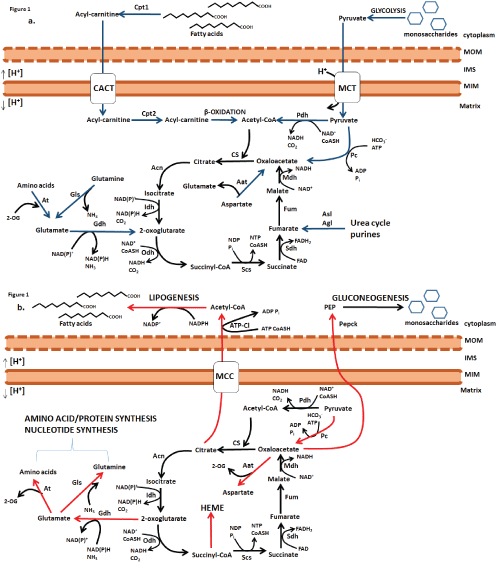
 |
| Figure 1: Catabolic and anabolic reactions of the oxidative Krebs cycle. a) Nutrients in the form of monosaccharides, lipids, amino acids, and nucleotides are metabolized by glycolysis, fatty acid oxidation, and various other cascades forming common metabolic intermediates acetyl-CoA, oxaloacetate, 2-oxoglutarate, and fumarate which enter the Krebs cycle for further oxidation. Prior to conversion to acetyl-CoA the end product of glycolysis pyruvate is transported into the matrix by monocarboxylate transporter (MCT). Note that conversion of pyruvate to acetyl-CoA is catalyzed by pyruvate dehydrogenase (Pdh) which couples pyruvate oxidation to NADH production and evolution of CO2. Pyruvate is also converted to oxaloacetate by pyruvate carboxylase (Pc). Fatty acid uptake by mitochondria is initiated by formation of acyl-carnitine, a reaction catalyzed by carnitine palmitoyl transferase 1 (Cpt1). Acyl-carnitine is then taken up by mitochondria via the carnitine acyl-carnitine translocator (CACT) where, upon entering the matrix, acyl-carnitine is converted back to acyl-CoA by Cpt2 prior to being subjected to β-oxidation. Amino acids are deaminated generating glutamate which enters the Krebs cycle following removal of NH3 by glutamate dehydrogenase (Gdh), a reaction that is coupled to NAD (P) H production. Aspartic acid also enters the Krebs cycle at the level of oxaloacetate, a reaction that is catalyzed asparate aminotransferase (Aat). Purine metabolism and urea cycle function also provide fumarate via the action of adenylosuccinate lyase (Asl) and arginosuccinate lyase (Agl). Upon entry into the oxidative Krebs cycle carbon is oxidized to yield NADH and FADH2 at various steps. Production of NADH at the levels of Idh and Odh is coupled to the release of CO2. Electrons from NADH and FADH2 are then mobilized by Complex I and Sdh (Complex II) and passed to O2 at the level of Complex IV. Electron transfer is coupled to the establishment of a transmembrane potential of protons which is tapped by Complex V for the production of ATP. b) For anabolic reactions, carbon from the Krebs cycle is diverted towards the biosynthesis of various building blocks required for the production of biological macromolecules (membranes, proteins, and DNA). Citrate is exported into the cytosol by mitochondrial citrate carrier (MCC) where it is cleaved by ATP-citrate lyase (ATP-c1) producing acetyl-CoA, the starting material for lipogenesis. 2-oxoglutarate can be diverted to serve as an ammonia acceptor generating glutamate. Glutamate is then utilized to generate glutamine via glutamine synthase (Gls) or can be utilized for the genesis of other amino acids including aspartic acid at the level of oxaloacetate. Amino acids yielded from Krebs cycle intermediates are then utilized for protein biosynthesis. Glutamate, glutamine, and aspartate are also utilized for nucleotide production. Succinyl-CoA is utilized for heme biosynthesis and oxaloacetate can be committed to gluconeogenesis and glucose production by phosphoenolpyruvate carboxykinase (Pepck). At; aminotransferase, Cs; citrate synthase, Acn; aconitase, Idh; isocitrate dehydrogenase, Odh; 2-oxoglutarate dehydrogenase, Scs; succinyl-CoA synthetase, Sdh; succinate dehydrogenase, Fum; fumarase, Mdh; malate dehydrogenase, 2-OG; 2-oxoglutarate. |